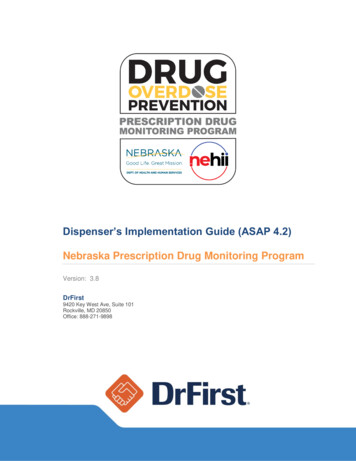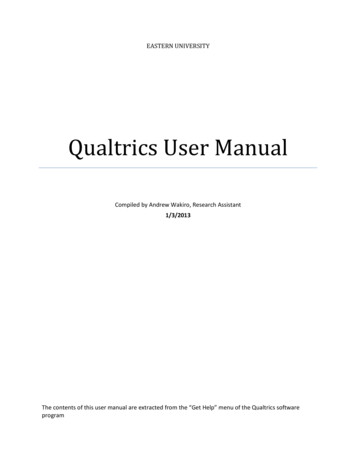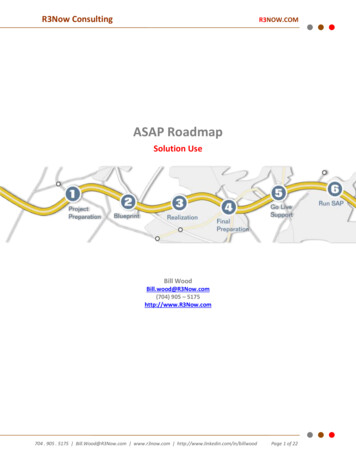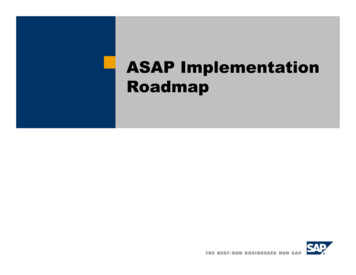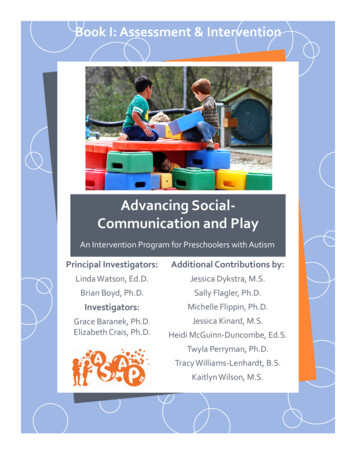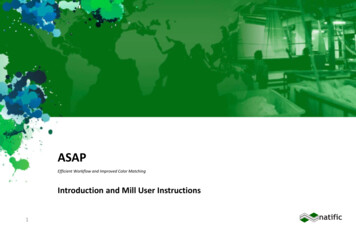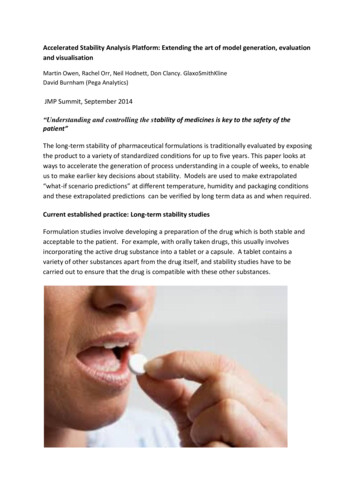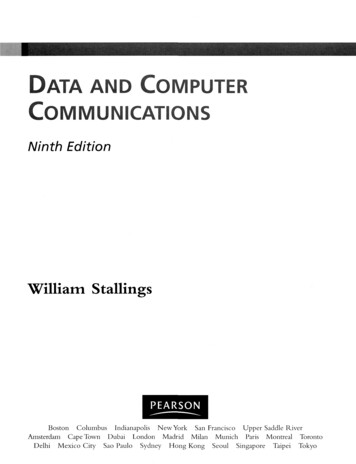
Transcription
ASAP SURVEY RESULTS:A Report on AdministrativeProfessionals and ExecutiveAssistants in North America (2020)PRODUCED BY:
ASAP SURVEY RESULTS:A Report on AdministrativeProfessionals and ExecutiveAssistants in North America(2020)I.Introduction 3II.Survey Highlights 4III.Demographics Profile 6IV.Position Titles 10V.The Responsibilities of the Role 11VI.Technical Expertise or Skill Level 13VII.Profiles and Progression of the Role 15VIII.Compensation 16IX.Certification 17X.Organizational Positioning and Reporting Structure 18XI.2020 Impact of COVID-19 on Training and Workplace 20XII.Summary 21Appendix: Job Responsibilities 22Appendix: WAS 2018 Survey, Job Titles 25
I. IntroductionThe role of administrative professionals has evolved in the last decade to become quitediverse and demanding. Following a cycle of rapid growth and engagement, the AmericanSociety of Administrative Professionals (ASAP) received a record number of requests forassistance in defining the profession and providing resources for its members to use inself-advocacy. In the spring of 2020, as the COVID-19 pandemic emerged, ASAP undertookits first industry research project, the largest benchmarking survey ever of North Americanadministrative professionals (APs) and executive assistants (EAs).The goals of this survey were to:1. Establish a baseline of current AP and EA responsibilities in 2020.2. Create a foundation for documenting trends in the evolution of the profession.3. Help individuals understand how they fit into the profession.4. Help companies and organizations understand this diverse talent pool.5. Identify development opportunities for ASAP to act as an advocate for the profession.6. Help individuals in this profession identify career opportunities.Executive and administrative professionals play a crucial role in the operations of anyorganization and in the support of its leadership. Those with the right knowledge and skills willbring benefits to numerous teams and help leadership to better advance corporate goals. APsand EAs are no longer just performing the tasks that secretaries performed, although those doremain core to the role in many companies. The paths individuals have followed that have ledthem to this profession are diverse, and the breadth of knowledge they bring with them andacquire on the job is vast.The role of this profession is evolving rapidly, and the current snapshot of responsibilitiesreflects a trend that the role is impacted by economic swings, technological advances, andworkplace norms. All of those will continue to shape the profession, but it is also beingimpacted by lesser, yet still significant shifts in management and generational leadershipstyles, corporate structures unique to specific industries, and even the impact of the globaltrends brought about by mergers and acquisitions.MethodologyNote: All executive assistants (EAs) are considered to be administrative professionals (APs). Not all APs are EAs.This initial survey was sent to the ASAP subscriber database of 109,456 administrativeprofessionals. Roughly half of those are members of ASAP; the remainder are administrativeprofessionals who have participated in a variety of professional development activities withASAP but are not formally members. 6,050 respondents completed and returned the surveyfor a 6% return response rate. The margin of error on the survey is /- 1.2% for a confidencelevel of 95%. The survey was conducted online between April 24-May 14 of 2020. Published by the American Society of Administrative Professionals 2020.Reproduction of this document in part or in its entirety is expressly prohibited.To request permission, contact us at info@asaporg.com.A REPORT ON ADMINISTRATIVE PROFESSIONALS AND EXECUTIVE ASSISTANTS IN NORTH AMERICA (2020) Published by the American Society of Administrative Professionals 2020. Reproduction of this document in part or in its entirety is expressly prohibited.3
II. Survey HighlightsAdministrative professionals are loyal and stable employees. In general, they make a careerof the profession and remain with their organizations longer than the average employee.Considering the costs HR experts cite for employee turnover, APs length of tenure makesthem a wise investment for training and development. Their institutional knowledge positionsthem as holders of intellectual capital for their organizations. Administrative professionals are relied upon to play a critical role in:{Facilitating communication across the organization.{Contributing to efficient, effective management of the organization.{Organizing work; getting things done.{Increasingly, making things happen that are aligned with organizationalobjectives. The primary work of the AP can be loosely grouped into five categories:1.Organizational communication.2. Task-related responsibilities.3.Management support.4.Processes and procedures.5. Project management.There is not a definitive correlation between job title and responsibilities.In many cases, companies/organizations have standardized titles foradministrative professionals, even when their job descriptions and jobresponsibilities differ substantially. More than a third of respondents are executive assistants or senior/chiefEAs. Secretary and executive secretary titles made up only 2% of titles. 70% work in organizations that employ more than a thousand people;44% work in companies with 10,000 employees.There isno definitecorrelationbetweenjob title andresponsibilities. APs often act as ad hoc managers, for both people and projects. Compensation is between 50,000 and 100,000 USD for half ofadministrative professionals. Certification continues to be a key distinguisher in the profession. Nearly a quarter(23%) of respondents hold a professional certification. PACE (offered by ASAP) and CAP(offered by IAAP) remain the primary certifications; both certifications are designed tobuild knowledge and competencies around the breadth of key responsibilities discussedthroughout this report.A REPORT ON ADMINISTRATIVE PROFESSIONALS AND EXECUTIVE ASSISTANTS IN NORTH AMERICA (2020) Published by the American Society of Administrative Professionals 2020. Reproduction of this document in part or in its entirety is expressly prohibited.4
Most APs report to and partner with senior leadership. 40% report directly to the CEO,president, other C-suite roles, exec director, EVP or SVP, dean or managing director.Another 35% report to directors, VPs or senior managers. Slightly more than half support 2-9 execs or managers; only 14% support one manager/executive. Juggling multiple priorities, supporting multiple people, and an increasedworkload are major challenges. 70% do not supervise or have direct reports. Tenure in the profession is somewhat evenly split across all four deciles presented, fromunder 10 to over 30 years. Administrative professionals are increasingly called upon to be available outside ofbusiness hours; disconnecting during their personal time is a primary challenge. Only a month into the pandemic, 76% were working from home. The top new skills needed in the 30 days preceding the survey were identified asfollows:{{Videoconferencing or remote meeting tools (Zoom, GoToMeeting, WebEx,Adobe Connect, Teams, etc.).Collaboration tools (SharePoint, Teams, Slack, etc.).When respondents reported their level of expertise in these areas, neither wasviewed as a strength, although they are more proficient in videoconferencing andremote meeting tools than in the use of collaboration tools.A REPORT ON ADMINISTRATIVE PROFESSIONALS AND EXECUTIVE ASSISTANTS IN NORTH AMERICA (2020) Published by the American Society of Administrative Professionals 2020. Reproduction of this document in part or in its entirety is expressly prohibited.5
III. Demographics Profile92% of Respondents Work Full TimeThe U.S. Department of Labor reports 43% of all female workers and 57% of all maleworkers are full time. It is hard to know whether the 92% of APs represents all administrativeprofessionals; it may be that in the general population there are more part-time workers, andthis survey did not reach them, or they did not respond. It does seem likely that given otherdemographics such as workplace setting and size of company, the percentage of full-time APsis significantly higher than the national average for all workers.Age35%31%20%9%4%1%Under 2525-3435-4445-5455-6465 AgeThe majority of APs (55%) are between the ages of 34 and 54. 35% are 55 and older, and thelargest percentage of respondents was 45 or older (70%), suggesting that organizations mustconsider succession planning since a significant number of workers are either in the secondhalf of their careers or nearing retirement. Only 10% are younger than 35, which may be dueto barriers to entry caused by existing staff’s long tenure in the field. Unfortunately, this makesit hard for younger talent to break into it, although it would appear this is starting to change.Examination of previous research on the profession compared to this data would suggest thatthe average age of administrative professionals has declined over the past decade.Participation in AP and EA events and membership in associations andcommunities supporting this profession provide some anecdotal evidence thatthe field is starting to trend younger. Existing industry data supports this and isaligned with overall workplace trends in North America as supported below. The International Association of Administrative Professionals (IAAP)membership survey conducted in 2018 found that the percentage of APs40 and under was 32%, up from 20% in 2015. Prior surveys also foundthat 60% had 20 years of experience, 15% higher than the tenure datathis survey collected.The average ageof administrativeprofessionalshas declinedover the lastdecade.A REPORT ON ADMINISTRATIVE PROFESSIONALS AND EXECUTIVE ASSISTANTS IN NORTH AMERICA (2020) Published by the American Society of Administrative Professionals 2020. Reproduction of this document in part or in its entirety is expressly prohibited.6
This evolution approximately mirrors the population distribution by generation in theU.S. in general. (According to Statistica, Baby Boomers comprise 21% of the population,20% are Generation X, 22% are Millennials, and 20% are Generation Z.)Tenure in the Profession 26% have less than ten years’ experience as an administrative professional. 29% have been in the role for 10-19 years. 45% have 20 or more years of experience.A 2018 SnackNation survey that showed more than a third of executive assistants have beenat their current company/organization for more than five years (a number greater than thenational average). This suggests a high degree of stability and loyalty.Educational credentialing of administrative professionals has increased in the 21st century.In 2020: One-third (31%) completed high school but did not receive a post-secondary degree. One-quarter (26%) have an associate’s/two-year degree. One-third (33%) have obtained a bachelors’ degree. 9% have a graduate degree.Note: Although not statistically significant, of the 6,050 respondents, 18 have obtained adoctorate.Highest Level of Education1%did not completehigh school33%Bachelor’sdegree31%High degreeThe ASAP survey shows an increase in educational attainment in the past two years.IAAP’s 2018 survey of administrative professionals indicated only 5% of respondents hada graduate degree, 6% a high school diploma and 18% a two-year degree. We wouldconjecture that educational requirements and expectations have evolved, with organizationsdemanding higher educational levels from new administrative hires, with bachelors’ degreesbeing preferred.A REPORT ON ADMINISTRATIVE PROFESSIONALS AND EXECUTIVE ASSISTANTS IN NORTH AMERICA (2020) Published by the American Society of Administrative Professionals 2020. Reproduction of this document in part or in its entirety is expressly prohibited.7
A note about gender: While this survey did not ask respondents about their gender identity,99% of ASAP members and subscribers who chose to complete a gender demographicquestion on their account profile identify as female. Additionally, attendees at ASAP’sAdministrative Professionals Conference (APC) are 98-99% female-identifying each year. Otherindustry data has indicated that while the number of males in the profession is increasing,females still make up more than 95% of administrative professionals.Corporate/Organization Profile:Top industries represented 26% of respondents work for education/nonprofit organizations, institutions orassociations. 16% are in the medical/healthcare field. 8% are in the financial/banking/insurance industries. 8% work for federal or local government/the public sector/military organizations.The industry profile is likely affected by the overall economy, with stronger, more robustindustries, bigger organizations with larger leadership teams, or industries with a great numberof office workers employing the greatest number of administrative and executive supportspecialists. A full breakdown of responses provides additional context to the more %1%4%1%1%3%1%0%1%0%1%17%Education or Non-Profits(associations and organizations)Medical/HealthcareFinancial Services/Banking/InsuranceFederal/National Government(Public Sector/Military)Regional/Local GovernmentManufacturing/Oil & Gas/Energy Management2%Information Technology/Computer Technology t Selling or efense Contracts/ContractorBiological loyment & TrainingInternet Retail/EcommerceOtherA REPORT ON ADMINISTRATIVE PROFESSIONALS AND EXECUTIVE ASSISTANTS IN NORTH AMERICA (2020) Published by the American Society of Administrative Professionals 2020. Reproduction of this document in part or in its entirety is expressly prohibited.8
Company/Organization SizeAn important differentiator and influencer we looked at was the difference between overallcompany size and the number of peers at the respondent’s particular corporate location.Anecdotally, the latter has been a key influencer in ASAP members’ job satisfaction.The greater the number of APs at any given location, the higher the likelihood they will havea peer community and a support system, enabling them to grow within their role. In addition,the larger the company, the more likely it is that there are better fleshed-out company policiessupporting their roles and stronger definitions of the roles’ responsibilities. 44% work for corporations that have 10,000 employees. 8% work for businesses or organizations with fewer than 150 total employees, but 39%work at a location with fewer than 150 employees. While 70% work in organizations that employ more than 1,000 people companywide,only 26% work in a location with more than 1,000 people.The data points toward the fact that larger organizations/companies are more likely to employadministrative professionals to provide management support. 56% of respondents work in locations where there are fewer than 10 APs. 26% work in organizations that employ more than 200 APs companywide, but only 5%work in a location with more than 200 APs.A REPORT ON ADMINISTRATIVE PROFESSIONALS AND EXECUTIVE ASSISTANTS IN NORTH AMERICA (2020) Published by the American Society of Administrative Professionals 2020. Reproduction of this document in part or in its entirety is expressly prohibited.9
IV. Position TitlesGiven the variety of industries in which administrative professionals workand the diverse functions of their executives/managers, it is no surprisethat there is a significant range of titles for administrative professionals.Survey data from the World Administrators Summit (WAS) survey in 2018 (SEEAPPENDIX: WAS 2018 SURVEY, JOB TITLES) found global respondents reported 25 mostcommonly utilized job title categories, and an IAAP survey in 2018 found thatrespondents reported more than 500 different job titles. Nor is it surprisingthat job descriptions and responsibilities are not standardized across titles. Ourrespondents reported their current titles as follows:The title“executiveassistant”is on theincrease. 34% of respondents are executive assistants or senior/chief EAs. 32% are administrative assistants, senior/chief AAs or administrative coordinators. 4% were office managers. Other middle-manager titles ranged from team lead, business assistant/analyst, andpersonal assistant to project specialist, management assistant, and chief of staff. A variety of other (non-assistant) administrative titles were reported at about 1% each,including associates, specialists, officers, and managers/supervisors. Notably, secretary and executive secretary titles made up only 2% of all titles.NOTE:In the mid- to late-20th century, the title of secretary/executivesecretary was ubiquitous; that title is much less common in 2020.Job Title of Administrative ProfessionalExecutive Assistant29%Administrative Assistant22%Senior Administrative Assistant6%Senior Executive Assistant5%Administrative Coordinator4%Office Manager4%Office Manager5%Administrative Associate2%Administrative Specialist2%Administrative Services Manager or Supervisor, Administrator or Administrative Officer,Business Assistant (including Business Administrator), Chief Executive Assistant (or ChiefAdministrative Assistant), Executive Secretary, Office Assistant, Operations Manger, ist, Secretary, Team Lead or Team Administrator1% eachBusiness Analyst, Chief of Staff, Management Assistant, Personal Assistant, ProjectManager, Virtual Assistant 1% eachOther14%A REPORT ON ADMINISTRATIVE PROFESSIONALS AND EXECUTIVE ASSISTANTS IN NORTH AMERICA (2020) Published by the American Society of Administrative Professionals 2020. Reproduction of this document in part or in its entirety is expressly prohibited.10
V. The Responsibilities of the RoleThe primary work of an EA or administrative professional can be loosely grouped intofive categories: organizational communication; task-related responsibilities; managementsupport; processes and procedures; and project management. Through this lens, we see thatadministrative professionals are relied upon to play a critical role in facilitating communicationacross the organization; contributing to efficient, effective management of the organization;organizing work; getting things done; and, increasingly, engaging in activities that furtheroverall organizational objectives. Research by Robert Half indicates that administrativeprofessionals save their executives/managers approximately eight hours each week.Five Categories of ResponsibilityOrganizational CommunicationA major role is organizational communication, such as generating/distributing company-widecommunications, maintaining collaborative relationships among stakeholders, and preparing/issuing pertinent company correspondence.Task-Related ResponsibilitiesToday’s APs also manage a myriad of day-to-day tasks. Examples include mail andcorrespondence management, management of phone and other office system equipment,supplies inventory, maintenance of office/visitor/meeting room amenities and supplies, recordkeeping, as well as routine photocopying and filing.Management SupportAPs hold critical responsibilities in a variety of management support roles on behalf of theirexecutive and/or management team. Most administrative professionals are responsible formanaging their superior’s calendar, including appointments, meetings, conferences, travel,and the oversight of post-travel expense reports. In addition, APs also hold leadership roles inmanaging special projects for the organization. For example, these may include initiatives suchas recycling, office renovations, or social events.Processes and ProceduresAt least half of APs indicate they oversee processes and procedures in the workplace. Theseinclude managing processes for paper and electronic record-keeping storage and retrieval;overseeing record-keeping for company office space, phones, credit cards, and keys;maintaining organizational charts; and seeking process improvements and improved officeprocedures, among others. Project Management (Including Event Coordination)Project Management (Including Event Coordination)Planning meetings and events has become a primary responsibility for many APs and EAs.A separate study of EAs reports that 90% are responsible for meeting and event planning.Furthermore, IAAP research shows meeting planning to have seen the greatest increase indemand for new skills in the past five years. While APs have less involvement with projectmanagement roles compared to other job duties presented in the study, they are increasinglychallenged to manage a variety of projects and to lead project teams. Comparisons topast survey data show that this is one of the largest growth and opportunity areas for theprofession.A REPORT ON ADMINISTRATIVE PROFESSIONALS AND EXECUTIVE ASSISTANTS IN NORTH AMERICA (2020) Published by the American Society of Administrative Professionals 2020. Reproduction of this document in part or in its entirety is expressly prohibited.11
APs often act as ad hoc managers of teams and projects, and to be successful, many areupskilling. In ASAP’s training and professional development offerings, project managementproducts and resources have become particularly popular in the past five years. Applicationsfor ASAP’s annual Executive Assistant Summit show that their bosses are increasingly lookingto them to be stronger project leads.Most Common Administrative ResponsibilitiesAcross all job titles, three-quarters of respondents indicate they have responsibility for thefollowing tasks as part of their complete position. (APs may hold duties in addition to theseand often do. Note that the survey did not weigh level of importance or time spent on theseduties.) Facilitate internal communications (e.g., distribute information and schedule meetings orpresentations). Perform general clerical duties, including but not limited to phone systems,photocopying, faxing, mail distribution, and filing. Maintain collaborative relationships with customers, management, and employees. Compose and/or prepare correspondence. Answer organizational mail, email, correspondence, and requests for information. Coordinate executive/management schedules through planning and schedulingappointments, meetings, conferences, and teleconferences. Order or oversee the purchase of office products, services, and supplies; maintaininventory of office supplies. Plan meetings and events (e.g., conferences, board/governance meetings, executiveretreats, strategic planning days). Coordinate expense reports post-travel. Organize and supervise other office projects, events, and activities (e.g., recyclingprograms, renovations, social events, etc.). Maintain office, visitor, and meeting spaces, providing needed amenities and supplies. Set up and manage and/or update paper or electronic filing systems, records, andreports.NOTE:Survey responses did not indicate a definitive correlation between job title and responsibilities.In many cases, companies/organizations have standardized titles for administrativeprofessionals, even when their job descriptions and job responsibilities differ substantially.NOTE:Note: For more details on the responsibilities of this role, see Appendix: Job Responsibilities.A REPORT ON ADMINISTRATIVE PROFESSIONALS AND EXECUTIVE ASSISTANTS IN NORTH AMERICA (2020) Published by the American Society of Administrative Professionals 2020. Reproduction of this document in part or in its entirety is expressly prohibited.12
VI. Technical Expertise orSkill LevelThis ASAP survey focused on technical skills used by and expected of administrativeprofessionals; it asked respondents to self-report their level of expertise in a variety of areas.The survey did not ask respondents to indicate which skills were used most often or whichskills were most in demand; those elements will be explored in future surveys. What we seeis that respondents’ greatest level of expertise lay in the skills that are most aligned with theirprimary areas of responsibility; the skills with which they have the least expertise are related todeveloping or emerging responsibilities and will be developed based on demand.Greatest level of expertise: Email and calendar management. Meeting and event coordination and management. Internet research. Document tools, e.g., Word, Acrobat, Google Docs. Travel tools, e.g., Tripit, Concur. Spreadsheet tools, e.g., Excel, Google Sheets. Minute-taking. Presentation software, e.g., PowerPoint, Prezi, Slides. Video conferencing or remote meeting tools, e.g., Zoom, GoToMeeting, WebEx,Microsoft Teams.Areas of Opportunity Requiring More Training: Design, graphics, and layout software. Project management software or tools. Social media for business purposes. Data analysis and insights. Budget management, monitoring, and tracking at corporate or organizational level. Technical writing.NOTE:ASAP plans a follow-up report analyzing sections V and VI with data beingcompiled from EA boss responses to questions about skill and task needs.A REPORT ON ADMINISTRATIVE PROFESSIONALS AND EXECUTIVE ASSISTANTS IN NORTH AMERICA (2020) Published by the American Society of Administrative Professionals 2020. Reproduction of this document in part or in its entirety is expressly prohibited.13
Level of Expertise with SkillsetsAdvancedProficientBeginnerEmail and calendar managementMeeting/event coordination/management (maximum 50 guests)Internet researchMeeting/event coordination/management (51 guests)Document tools (Word, GDocs, Acrobat, etc.)Travel tools (Concur, TripIt, Google Trips, Travo, etc.)Videoconferencing or remote meeting tools(Zoom, GoToMeeting, WebEx, Adobe Connect, Teams, etc.)Spreadsheet tools (Excel, Sheets, etc.)Minute-takingPresentation software (PowerPoint, Slides, Prezi, etc.)Board management/coordinationReportsDatabase managementCollaboration tools (SharePoint, Teams, Slack, etc.)Budget management/monitoring/tracking at project levelBudget management/monitoring/tracking at corporate/organizational levelProject management processesTechnical writingSocial media for business purposesDesign, graphics, and layout software (Publisher, Photoshop, InDesign, etc.)Data analysis and insightsProject management software or toolsA REPORT ON ADMINISTRATIVE PROFESSIONALS AND EXECUTIVE ASSISTANTS IN NORTH AMERICA (2020) Published by the American Society of Administrative Professionals 2020. Reproduction of this document in part or in its entirety is expressly prohibited.14
VII. Profiles and Progressionof the RoleDespite the variety within the profession of how the role is structured, utilized,and staffed, patterns emerged from the survey responses that indicatea cluster of duties and skills with three distinct profiles. Although there iscurrently little standardization for the roles across North America, theseprofiles suggest some alignment is possible.1. Foundations/essentials roles: Have fewer responsibilities. Possess lower level of skills and expertise. Have spent less time on the job.Administrativeprofessionals’roles fallwithin threedistinctprofiles. Are not likely to be supervising anyone.2. Practicing/intermediate skill roles: Have increased responsibility. Are not yet involved in much project management. Don’t often act as management surrogates.3. Expert/advanced roles: Have the highest expertise in all areas. Undertake more duties in addition to existing ones, such as project management. Regularly act as surrogates for the executive/manager. Are more educated. Are most likely to have direct reports. Tend to be more highly compensated.A REPORT ON ADMINISTRATIVE PROFESSIONALS AND EXECUTIVE ASSISTANTS IN NORTH AMERICA (2020) Published by the American Society of Administrative Professionals 2020. Reproduction of this document in part or in its entirety is expressly prohibited.15
VII. CompensationSlightly more than half of administrative professionals are paid hourly, and 44% are salaried.Most management positions are salaried; however, hourly pay does have the advantage in thatthese roles are generally considered non-exempt and organizations are therefore obligated topay for overtime hours. 35% of respondents report making under 50,000 USD yearly. 50% are paid 50,000-100,000 yearly.Annual CompensationUnder 30,00006% 30,000 - 39,99912% 40,000 - 49,99917% 50,000 - 59,99917% 60,000 - 69,99914% 70,000 - 79,99910% 80,000 - 100,0009% Senior AA: 58,213Over 100,0004% AA: 44,285Prefer not to answer12% 4% make more than 100,000 a year.When we calculated the interpolated medians of the compensation fordifferent job titles based on salary, we found the following. Senior EA
The ASAP survey shows an increase in educational attainment in the past two years. IAAP's 2018 survey of administrative professionals indicated only 5% of respondents had a graduate degree, 6% a high school diploma and 18% a two-year degree. We would conjecture that educational requirements and expectations have evolved, with organizations
